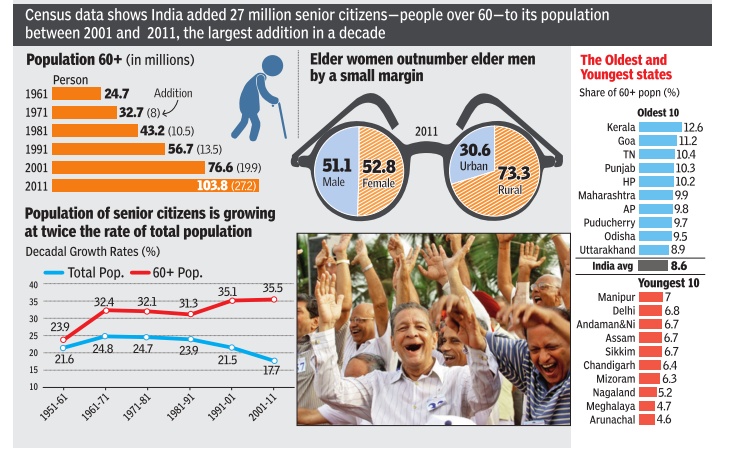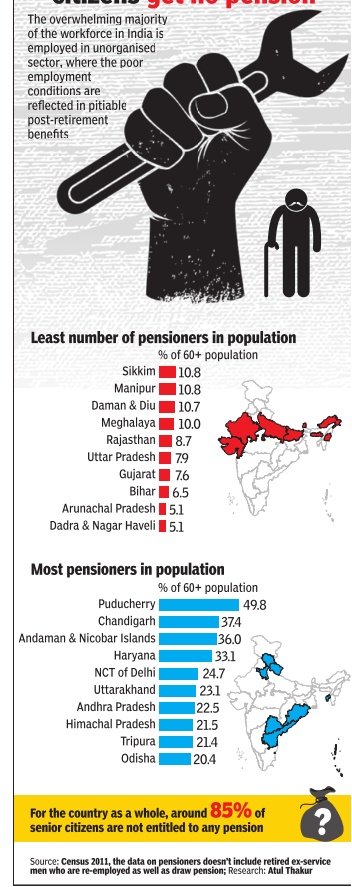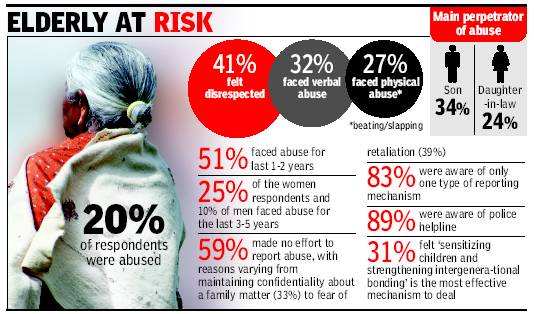Senior citizens/ Elders: India


This is a collection of newspaper articles selected for the excellence of their content. |
Contents |
Definition of senior citizen/ 2017
Govt To Replace 20-Year-Old Elders' Policy
The Centre unveiled its plan in the Supreme Court to replace a nearly two-decade old `national policy on older persons' with new norms that will keep the age uniform across sectors for persons to be counted as senior citizens to avail benefits under the government's social welfare schemes.
At present, the insurance sector recognises persons over 65 years as senior citizens, the railways offers con cessional tickets to men above 60 years and women over 58 years, income tax exemptions apply differently to persons over 60 years and 80 years, and old age pension is given at the rate of Rs 200 per month to those over 60 years and Rs 500 to those above 80 years.
Responding to a petition by former law minister Ashwani Kumar for all-round ameliorative measures for senior citi zens, additional solicitor general Pinky Anand informed a bench of Justice Madan B Lokur and Justice Abdul Nazeer that “as per departmental action plan on recommendations of group of secretaries, uniform adoption of age criteria for benefits to senior citizens (airlines, state governments, insurance companies, etc) is under consideration“.
“The ministry of social justice and empowerment is in the process of suitably revising the National Policy on Older Persons, 1999, keeping in view the changing demographic pattern, socio-economic needs of senior citizens, social value system and advancement in the field of science and technology over the last decade and bringing out a National Policy for Senior Citizens,“ Anand said.
Importantly , the Centre said it was working on a mechanism to regulate home care services for elderly being offered by various private firms.“Rating of organizations providing home care services is under consideration, as is the creation of regulatory mechanism to prescribe standards for establishing and providing quality services for senior ci tizens. The rating of facilities provided by home care services to senior citizens would enable them to make informed choices,“ she said.
Kumar alleged that successive governments have been planning and formulating schemes but nothing has reached the needy , who in the sunset years were leading a life in abject neglect and suffering.“There are not even enough old age homes in the states,“ he said. The bench sought a status report on number of old age homes in states from the Centre and states.
The Centre said it was giving pension to over 55.5 lakh retired central government employees to help them lead a life with dignity . It said retired defence personnel constituted the bulk of them at 25 lakh, number of retired railways pensioners stood at 14.34 lakh, while retired civil pensioners were over 10.18 lakh.
Amicus curiae, NGO “Helpage India“, requested the court to direct the Centre to increase the monthly old age pension from Rs 200 to Rs 2,000 as the present pension mocked the dignity of senior citizens. It said the increase could cost the government Rs 91,776 crore annually.
“There needs to be at least one old age home in each of the 707 districts to be able to house 1,06,050 older indigent persons. But, according to a WHO study , there will be 3,53,500 older indigent persons requiring high-level care and this will require at least four old age homes per district,“ it said.
Benefits mandated by the government
Budget 2018
Heyday for grey days: Seniors get triple break, February 3, 2018: The Times of India
The finance minister proposed to extend the Pradhan Mantri Vaya Vandana Yojana till March 2020 under which an assured return of 8% is given by the Life Insurance Corporation of India. The existing limit on investment of Rs 7.5 lakh was doubled to Rs 15 lakh. At a time when fixed deposit returns are around 7%, this will help senior citizens get higher interest rates.
Opening a bag of goodies, the finance minister raised the exemption limit on income from interestby five timestoRs 50,000 per year. No TDS will be deducted from the interest income of senior citizens. Arun Jaitley also increased the limit of deduction for health insurance premium and medical expenditure to Rs 50,000 from Rs 30,000 under Section 80D. This additional deduction of Rs 20,000 will help a taxpayer save uptoRs6,000per annum.
The FM raised the limit of deduction for medicalexpenditure in respect of certain critical illnesses to Rs 1 lakh for all senior citizens, under Section 80DDB. Earlier, thislimitstood at Rs 60,000 for senior citizens and Rs 80,000 for very senior citizens. The concessions will cost the government Rs 4,000crore.
The assessee will need to furnish a medical prescription to avail of these benefits. The tax benefits can also be claimed by those who incur expenditure for buying health insurancepolicies, or spend on medical treatment of dependent senior citizens.
Confinement of elders to home
The Times of India, Apr 18 2016
34% of 80-yr-olds in villages and 27% in cities confined to homes
Mahendra Singh
About 8.4% of people aged 60 and above in villages and 7% in cities and towns are either confined to their home or bed and the incidence is higher for women , a government health survey has found. The survey underlines the dependency of older people on assistance and limitations on their mobility as the percentage of home-bound elders rises to 27% in urban and 34% in rural areas in the 80-plus age group.
The ability to get around is an important indicator of the physical condition and overall health of older persons. A large proportion of the elderly are also economically dependent on others for their livelihood. The NSSO survey found that around 52% of the aged in rural and 51% in urban had to depend on others for their day-to-day needs.
The dependence was very high for elderly women. About 90% of aged women in rural and 87% in urban areas were economically dependent either partially or fully . The problem points to the possibility that many were not formally employed and lacked retirement planning or even options. It was found that 43% of men in rural and 52% in urban areas were economically independent in terms of their livelihoods.
Most of the economically dependent aged people -82% in rural and 80% in urban areas -depended on their children for financial support while a sizeable proportion (11% in rural and 15% in urban areas) depended on spouses. A small proportion -5% in urban and 7% in rural areas -were supported by their grandchildren or `others' which includes non-relatives.
The survey found very few elderly lived alone in India. The figure was only 4% in both rural and urban areas. About 61% of the aged in rural and 63% in urban areas lived with spouses. Some 35% in rural and 33% in urban areas lived without spouses but with children or other relatives. The survey found that the percentage of elderly was 7.7% in rural areas and 8.1% in urban areas.
The sex-ratio among aged persons of 60 years and more was 1035 in rural India and 1029 in urban areas, indicating a higher life expectancy for women.
Problems with children
The Times of India 2013/06/15
Elderly have much to fear from their children TIMES NEWS NETWORK
New Delhi: Almost one-fifth of elders surveyed in Delhi have complained of abuse, says the latest data released by an NGO. The capital has the third highest rate of abuse after Hyderabad and Kolkata among five Tier-I cities that were surveyed.
TheHelpAgeIndia report‘Elder Abuse in India 2013’ that has covered 6,748 elders across 24 cities also found another unique trend in Delhi. While nationally, thedaughter-in-lawwasfoundto be the primary perpetrator of abuse, in Delhi it was the son followed by daughter-in-law. More than one fifth of the total respondents nationally said that they had faced abuse by caregivers or family members.
The nature of abuse ranged from disrespect to severe physical abuse. B R Sahni (82) for instance who attended the report launch was one of the thousands who complained to being beaten and slapped by his son.
“This report reveals the reality of elders in India. I moved to an old age home 4 years ago after being physically abused by my children. They said they couldn’t bear the costs of taking care of me. But I am very happy today at the ashram where I live. Not all elders get a shelter like I have,” he said.
Nationally, the highest number of abuse cases were seen in Madurai (63%) followed by Kanpur (60%). Among those who were abused over 16% from Rajasthan and 13% from Andhra Pradeshsaidthey were physically abused. Among Tier- II cities that were covered, Chennai had the lowest (9.64%) and Hyderabad had the highest (37.50%) cases of abuse.
The major reasons cited by the elderly for abuse were ‘lack of adjustment,’ ‘economic dependence of the abused,’ ‘increasing longevity’ and even ‘economic dependence of abuser.’ Most of the respondents (70%) did not report the abuse. Most felt that such family matters should be felt confidential and many feared retaliation.
Prominent jurist and India’s first woman judge, Leila Seth (82) also addressed the elders about the importance of not transferring property ownership before death. “I had thought of transferring the house in my daughter’s name. But a close lawyer friend had advised me not to do so. Today most elderly are abused because of property related issues,” Seth said.
